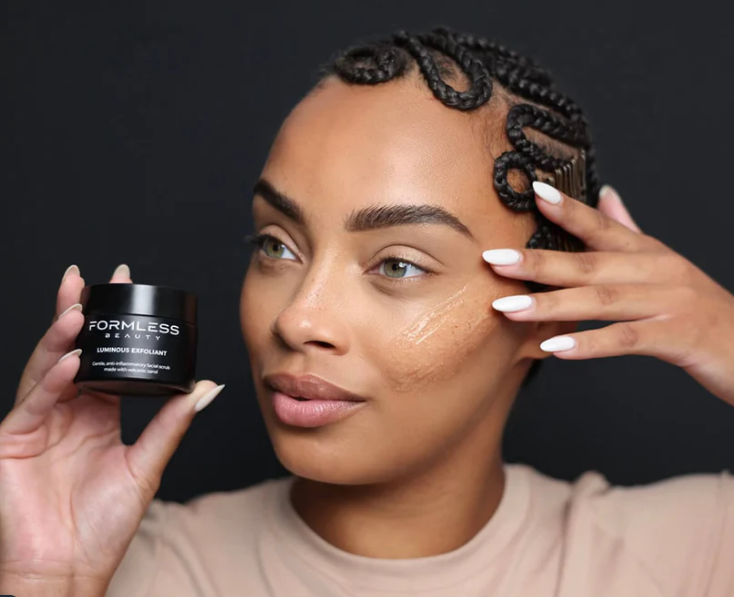The Science Behind Exfoliants: How They Boost Skin Renewal
Using an effective exfoliant is more than just about achieving a fresh, smooth complexion. Exfoliants play a powerful role in the natural process of skin cell renewal, helping to shed dead cells and encourage new growth for a brighter, healthier appearance. But how does this process actually work? Understanding the science behind exfoliating scrubs can help you make more informed choices and maximize their benefits in your skincare routine.
The Basics of Skin Cell Turnover:
Skin cell turnover is a natural process where new skin cells form in the lower dermis and travel to the outer layer (epidermis), replacing dead cells as they shed. This process keeps the skin looking youthful, vibrant, and healthy. However, as we age, skin cell turnover naturally slows down, resulting in a buildup of dead cells on the surface, which can cause dullness, uneven texture, and a lackluster tone.
In younger skin, cell turnover occurs roughly every 28 days. For mature skin, however, this process can slow to 45 days or longer, meaning dead cells accumulate on the surface for an extended period, blocking pores, and slowing natural radiance. An exfoliate scrub help to accelerate this cycle, encouraging new cell growth and a more youthful appearance.
Types of Exfoliants and Their Mechanisms:
There are two main types of exfoliants: physical and chemical. Each works differently to support skin renewal and has its own set of benefits and ideal uses.
Physical Exfoliants
Physical exfoliants are products that use small particles—such as sugar, salt, or microbeads—to manually buff away dead skin cells. When applied with gentle circular motions, these particles slough off the outer layer of dead cells, resulting in an immediate polished feel.
Benefits of Physical Exfoliator
- Instant Results: Physical exfoliants deliver an instant smoothing effect, which makes them appealing for those who enjoy immediate results.
- Easy Control: By adjusting the pressure you apply, you can control the intensity of the exfoliation.
However, physical exfoliate scrubs can sometimes cause microtears in the skin, especially if they contain large or rough particles. They are best suited for those with resilient, non-sensitive skin.
Chemical Exfoliants
Chemical exfoliants contain active ingredients that break down the bonds holding dead cells together, allowing them to be shed naturally. These exfoliants penetrate deeper than physical scrubs, making them highly effective for more intensive results.
The most common types of chemical exfoliants include:
- Alpha Hydroxy Acids (AHAs): Water-soluble acids like glycolic acid and lactic acid, which work on the skin’s surface to remove dead cells. AHAs are ideal for dry or sun-damaged skin, as they help boost moisture levels and improve overall radiance.
- Beta Hydroxy Acids (BHAs): Oil-soluble acids such as salicylic acid that penetrate deeper into pores to dissolve impurities and clear away dead cells. BHAs are especially effective for oily and acne-prone skin types, helping to reduce pore size and prevent breakouts.
- Polyhydroxy Acids (PHAs): Newer, gentler acids that work similarly to AHAs but with larger molecules, which makes them less likely to cause irritation. PHAs are suitable for sensitive skin types.
- Enzyme Exfoliants: Derived from fruits like papaya, pumpkin, or pineapple, enzymes work by breaking down the proteins in dead skin cells, making them ideal for a gentle exfoliation. Enzyme exfoliants are effective for all skin types and are especially beneficial for those with sensitive or redness-prone skin.
Benefits of Chemical Exfoliants:
- Even Exfoliation: Unlike physical exfoliants, chemical exfoliator provides an even exfoliation that works throughout the skin’s surface.
- Targeted Results: Chemical exfoliants can address specific concerns, like hyperpigmentation or acne, due to their ability to penetrate at various depths.
For a gentle, effective chemical exfoliation option, consider the Luminous Exfoliant Scrub by Formless Beauty, which combines the benefits of chemical and physical exfoliation for a balanced approach.
How Exfoliants Boost Skin Renewal?
Exfoliants work by removing the dead cells on the skin’s surface, triggering a signal to the lower layers of skin to produce fresh cells. Here’s a closer look at how exfoliator contribute to the skin renewal process:
- Stimulating New Cell Growth
By clearing away dead skin, exfoliate scrubspromote the faster appearance of new cells, which leads to a smoother and more vibrant complexion. This cycle also helps reduce the appearance of fine lines, wrinkles, and hyperpigmentation over time, as new, healthy cells reach the surface. - Unclogging Pores
Chemical exfoliants, particularly BHAs, penetrate into the pores and dissolve excess oil and debris. This prevents clogging and helps reduce the risk of blackheads, whiteheads, and acne. - Increasing Collagen Production
Some chemical exfoliants, such as AHAs, stimulate the production of collagen, a protein essential for skin’s firmness and elasticity. Increased collagen helps reduce the appearance of fine lines and contributes to a more youthful appearance. - Improving Product Absorption
Exfoliating removes the layer of dead cells that can hinder the penetration of other skincare products. After exfoliating, serums and moisturizers can absorb more effectively, making them more potent.
How to Incorporate Exfoliants Safely into Your Routine?
To make the most of your exfoliating products, follow these guidelines to safely incorporate them into your skincare routine:
- Introduce Exfoliants Gradually
If you’re new to exfoliation, start with a mild exfoliant once a week, such as a gentle enzyme or PHA-based product. Gradually increase the frequency as your skin adapts, paying attention to any signs of irritation. - Avoid Overlapping Exfoliating Products
Using multiple exfoliating products or layering an exfoliant with strong active ingredients can lead to irritation. Stick to one exfoliating product at a time, and avoid combining it with retinoids or high concentrations of vitamin C. - Follow with Moisture and Sun Protection
Exfoliation makes your skin more vulnerable to moisture loss and UV damage. Follow up with a hydrating moisturizer and apply sunscreen daily to protect freshly exfoliated skin from sun exposure.
Choosing the Right Exfoliant for Your Skin:
Different skin types benefit from different types of exfoliants. Here’s a quick guide to help you choose:
- Oily/Acne-Prone Skin: Look for a BHA exfoliant, as it can penetrate pores and reduce excess oil.
- Dry/Dehydrated Skin: AHAs are ideal, as they remove surface cells and help increase hydration.
- Sensitive Skin: Opt for enzyme or PHA exfoliants for a gentle yet effective exfoliation.
- Combination Skin: Try alternating between AHAs and BHAs to address both dryness and oiliness.
Final Thoughts:
Exfoliants are powerful tools in skincare, offering numerous benefits by accelerating skin renewal, unclogging pores, and enhancing product absorption. Incorporating the right exfoliant into your skincare routine can help you achieve smoother, healthier-looking skin. And with the holiday season upon us, now is a great time to explore skincare options with the Holiday Bundle from Formless Beauty, designed to give you radiant skin all season long. For more skincare essentials, visit the Formless Beauty.














Post Comment